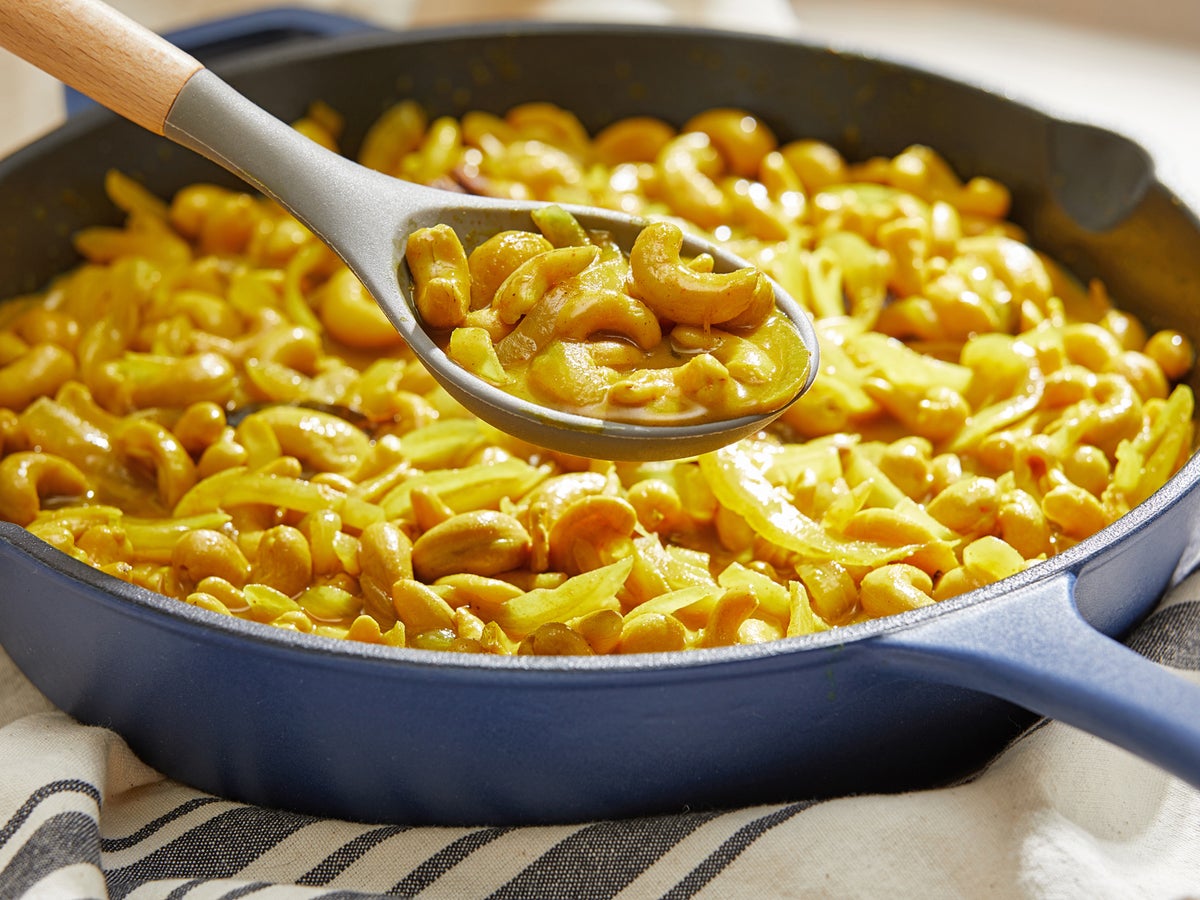
Chef O Tama Carey was serving dishes in her Sydney restaurant recently when a customer asked her a simple question: “What’s in the cashew curry?”
“And I said, ‘Cashews. It’s a cashew curry.’ And they were like, ‘But what else?’ And I said, ‘Cashews. Because it’s a cashew curry.’”
Carey is talking to me on a Zoom call on a night off from that acclaimed restaurant, Lankan Filling Station, and is explaining to me some of the differences between Sri Lankan food and other cuisines. “In other curries, especially in Thai food, if you have a cashew curry you might also get a lot of other stuff. But in a lot of Sri Lankan dishes, the main ingredient is just what it is.”
As someone who adores cashews but has grown accustomed to seeing them used in plant-based cooking as the makings of a dairy-free puree to add richness, I could imagine myself being that very diner asking those very questions. And I also know that once that dish made its way to my table, I’d be as giddy with excitement as I was when I made it at home.
In Carey’s lovely new book, Lanka Food, she explains and demystifies the cooking she learned from her Sri Lankan mother’s side of her family, and includes a fascinating rundown on the island’s influences, including Dutch, Portuguese and English colonisers and Arab, Malay and Chinese traders.
As a predominantly Buddhist nation, Sri Lanka boasts a wonderful variety of vegetarian cooking, so of course that was my own path into the beginnings of understanding the cuisine. This cashew curry recipe, which she calls “distinctly Sri Lankan”, is almost a lesson unto itself.
First, there are those cashews, which are not nuts at all but technically fruit; they’re the drupe seeds that extend under the apple of the cashew tree. In Sri Lankan markets, she says, it’s common to see not only the apple, which she compares in texture to an Asian pear, but the fresh cashews, which are juicier and plumper than anything we can get in the UK or US. (In processing, cashews are typically steamed to assist in the cracking of their shell, and must be handled carefully to avoid a toxic substance that can burn harvesters’ and processors’ hands. For this and other reasons, advocates for farmers and workers suggest that consumers of imported cashews look for fair-trade companies.)
Carey’s recipe calls for soaking the cashews first, which helps return some of that plumpness and softer texture to the dish, which also depends heavily on another crucial Sri Lankan ingredient: coconut cream. On the island, coconuts are typically pressed several times, with each pressing resulting in a less-rich product, and this is one of those dishes that would be made with the first pressing. Off the island, Carey compensates for the lack of ubiquitous coconut trees by starting with a canned coconut cream and adding different amounts of water for different uses.
The third element to this dish that exemplifies Sri Lankan cooking is its use of herbs and spices: fresh curry leaves, cumin seeds and ground turmeric, along with a curry powder that includes those plus a few more spices. In many ways, particularly the complex layering of spices and aromatics, it reminded me of an Indian paneer curry I made a few months ago. But it also tastes distinct: lighter, with a welcome tang from lime juice.
That brings me to Carey’s larger point about the cuisine of her heritage. When I ask her at the beginning of our conversation what she thinks is the most common misconception about it, she didn’t miss a beat: that it’s Indian food.
“There’s just so much more,” she says. And after making this dish, I can see – and taste – just what she means.
Cashew curry
Active time: 20 minutes | Total time: 45 minutes
Serves: 4 to 6
This Sri Lankan dish treats cashews more like legumes, simmering them whole until softened in an aromatic, creamy, vegan curry. It’s a delightful change from cashew-based vegan dishes in which the nut is blended into a sauce, or from using chopped nuts as a garnish. To make this recipe go faster, start by soaking cashews in the boiling water, then prep the rest of the ingredients.
Make ahead: The cashews need to be soaked 20 minutes before making the curry.
Storage notes: Refrigerate leftovers for up to 4 days.
Where to buy: Curry leaves and pandan leaves can be found at Asian supermarkets.
Notes: To make your own Sri Lankan-style white curry powder for this dish, toast 6 curry leaves in a pan over medium heat for a few minutes, then cool and combine in a dedicated spice grinder with 2 tablespoons coriander seeds, 1 tablespoon fennel seeds, and 2 teaspoons each nigella seeds, cumin seeds and turmeric powder. Grind to a fine powder. You should have about 2 tablespoons.
If you can’t easily find coconut cream, substitute an equal amount of full-fat coconut milk and reduce the amount of water to ½ cup.
Ingredients:
3 cups (700ml) boiling water, plus more as needed
400g raw cashews
2 tbsp coconut oil
6g curry leaves
1 tsp cumin seeds
2 medium yellow onions (400g total), thinly sliced
5 cloves garlic, finely grated or pressed
1½ tsp grated fresh ginger (from one 7½cm piece)
1 long green chilli, stemmed and finely chopped
2 tbsp curry powder (see notes)
1 tsp ground turmeric
½ tsp fine salt, plus more to taste
¼ tsp freshly ground black pepper
One (380g) tin or three (150g) tins unsweetened coconut cream (see notes)
One (7½cm) cinnamon stick
Two (5cm) pieces pandan leaf (optional)
1 cup (240ml) water
1 to 2 tbsp fresh lime juice, to taste
Cooked rice, for serving
Method:
In a large heatproof bowl, pour the boiling water over the cashews; they should be covered by at least 2½cm. Soak for 20 minutes, then drain.
In a deep pan over medium heat, melt the coconut oil. Add the curry leaves and cumin seeds and cook, stirring, until the curry leaves are fried and the seeds are aromatic, about 1 minute.
Add the onion, garlic, ginger and chilli and cook, stirring occasionally, until the onion begins to soften, 4 to 6 minutes. Add the curry powder, turmeric, salt and pepper and cook, stirring, until the spices are very aromatic and sticking to the bottom of the pan, about 1 minute.
Add the cashews and stir to coat well, then add the coconut cream, cinnamon, pandan leaf, if using, and water. Increase the heat to bring the mixture to a boil, then reduce the heat to medium-low so that the mixture is gently simmering, and cook, stirring occasionally, until the sauce has reduced and thickened, 18 to 20 minutes.
Stir in 1 tablespoon of the lime juice. Taste, and season with more salt, pepper and/or lime juice as needed. Serve hot, with rice.
Nutrition information per serving, based on 6 | Calories: 563; total fat: 47g; saturated fat: 22g; cholesterol: 0mg; sodium: 230mg; carbohydrates: 26g; dietary fibre: 4g; sugar: 6g; protein: 13g.
This analysis is an estimate based on available ingredients and this preparation. It should not substitute for a dietitian’s or nutritionist’s advice.
© The Washington Post







